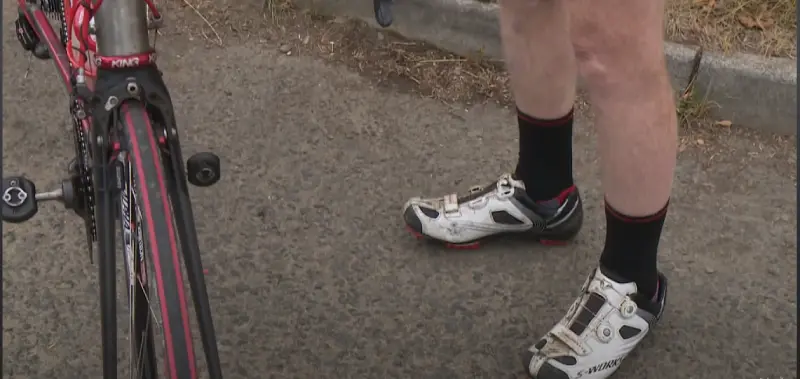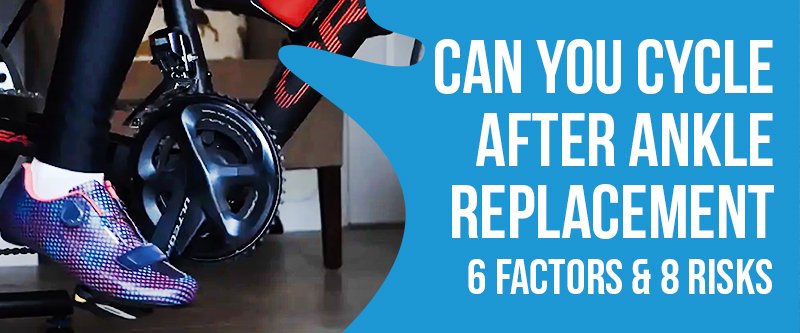Cycling too soon after ankle replacement surgery may damage the ankle joint. Cycling too early can delay your recovery time and lead to complications. Cycling may affect ankle replacement longevity and lead to early failure.
After ankle replacement surgery, it’s possible to resume cycling after 16 weeks of recovery. Clients can return to sedentary jobs and accumulate their activity level by walking and cycling.
In this blog post, we’ll dive into whether you can cycle after ankle replacement, the factors to consider when deciding whether to cycle after ankle replacement surgery, the dangers of cycling too soon after an ankle replacement, and the right time to cycle after surgery.
Can You Cycle After Ankle Replacement: 6 Factors To Consider

If you have had ankle replacement surgery, you may be eager to return to cycling as soon as possible. Several factors should be considered before deciding.
Ankle replacement surgery is a complex procedure that replaces a damaged ankle joint with a new one. Cycling after ankle replacement surgery requires consideration of several factors:
Healing Time
The first factor you should consider is healing time. After ankle replacement surgery, it can take several weeks or even months for you to heal fully. Wait for your surgeon’s approval to cycle again.
Your Surgeon’s Recommendations
Before you cycle again, discussing with your surgeon whether cycling is suitable for you and, if so, when it is safe to start is essential. Following your surgeon’s guidelines is crucial to ensure your ankle fully heals.
Pain Levels
Another factor to consider is your pain levels. If you experience pain during or after cycling, it may be a sign that you’re not fully healed yet. It’s essential to listen to your body and not push yourself too hard.
Range of Motion
Before cycling, you must ensure you have enough range of motion in your ankle. Your surgeon or physical therapist can determine if your ankle is ready for cycling.
Type of Bike
The type of bike you ride can also make a big difference in your post-surgery cycling experience. A stationary or recumbent bike can be a good option initially, as they place less stress on the ankle than a traditional bike.
Proper Gear
The right gear can help make cycling more comfortable and safe after ankle replacement surgery. Ensure you have proper cycling shoes that support a secure fit and a helmet to protect your head in case of a fall.
Ankle Replacement And Cycling: 8 Risks
It is important to note that recovery from ankle replacement surgery takes time, and patients must take care when returning to physical activities, such as cycling. Taking up bicycle riding too soon after ankle replacement surgery can lead to several complications that can hinder your recovery and even cause further damage to your ankle.
Bone Fractures

Too much cycling after an ankle replacement can lead to bone fractures in the replaced ankle because of excessive stress. This is because the bones in the ankle are still healing and are not fully strong enough to handle the strain of cycling.
Loosening of the Implant
Ankle replacement implants may become loose if a patient puts too much pressure on the ankle too soon after the surgery. Cycling, which requires a lot of repetitive motion and stress on the ankle, can increase the risk of implant loosening. This can cause joint instability, pain, and additional surgery to correct the problem.
Infection
After ankle replacement surgery, cycling too soon can make it harder to recover and cause complications. The incision site may become infected if proper care is not taken, and bacteria can be quickly introduced into the joint through cycling.
Poor Healing
Compromising the healing process can lead to poor results after surgery. Cycling too soon can put extra stress on the ankle, interfering with healing. This can lead to slow or incomplete healing, increased pain and discomfort, and delayed or limited mobility.
Ankle Swelling
Cycling can cause swelling in the ankle joint if done too soon after the surgery. Excessive swelling can cause discomfort and pain and may compromise blood flow to the ankle, which is vital for healing.
Instability and Falls
When a patient cycles too soon after an ankle replacement, it can lead to ankle instability, which can cause a patient to lose balance and fall. A fall can cause severe injury, which may require further surgery to correct.
Nerve Damage
Cycling too soon after the surgery can put pressure on the nerves around the ankle joint, causing damage. This can cause numbness or tingling sensations, pain, and limited mobility. It may require extensive rehabilitation to correct nerve damage.
Repeat Surgery
Ankle replacement surgery performed too soon can lead to complications that may require repeat surgery, which may compromise the success of the initial surgery.
7 Advantages of Cycling at the Right Time After Surgery
Cycling the right after ankle replacement surgery has many benefits for individuals who have undergone this procedure. Here are seven advantages of cycling that can make a difference in your recovery:
Improved Joint Mobility
Cycling helps to improve joint mobility by increasing blood flow and oxygenation to the joint. At the right time, cycling after ankle replacement can help reduce inflammation and stiffness and improve their range of motion.
Strengthening Leg Muscles
Cycling is an excellent exercise for strengthening leg muscles. Engaging leg muscles through cycling helps build strength and endurance for daily mobility tasks.
Low Impact Exercise

Cycling is a low-affected exercise that is easy on the ankle joint. This feature makes it an ideal exercise for recovering from ankle replacement surgery. By cycling, patients can gently engage their ankle joint without placing too much pressure on it.
Improved Cardiovascular Health
Cycling is a great cardiovascular exercise that improves heart health. If done right after ankle replacement, patients can increase their heart rate, which helps to burn calories and improve overall physical fitness. This feature is handy for those patients who experienced a loss of cardiovascular strength post-surgery.
Reduced Stress On Joints
Compared to other exercises, cycling has significantly less stress on joints. Cycling primarily focuses on leg muscles, while the saddle and handlebars support the patient’s weight. This feature helps to reduce pressure on joints and relieves any discomfort in the ankle joint.
Increased Endorphin Production
Cycling stimulates the production of endorphins, which are the body’s natural painkiller. This production can reduce pain levels and induce a feeling of well-being in patients after surgery.
Improved Digestion
Cycling can help improve digestion. Cycling stimulates general body functioning, including digestive movement in the intestines, which helps prevent gastrointestinal problems.
Conclusion
Cycling is a workable and healthy activity to undertake after ankle replacement surgery. With the right mindset, dedication, and caution, cycling can be crucial in speeding up your recovery and helping you resume your active lifestyle.
Follow your doctor’s instructions and accumulate your activity level until you’re fully confident and capable of tackling more challenging terrain.
Remember the importance of physical activity post-surgery and its benefit on your health and well-being. So, hop on that bike and pedal to a healthier and happier you.
FAQs
What Are The Precautions When Cycling After Ankle Replacement?
Yes, there are. You should wear proper cycling shoes that provide sufficient ankle support, avoid sudden movements or jerks, and stop cycling if you experience pain, swelling, or stiffness in your ankle. Adjust your bike’s saddle height and position to avoid excessively pressuring your ankle and ensure a comfortable and safe cycling experience.


